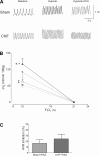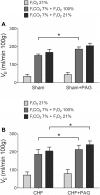Inhibition of hydrogen sulfide restores normal breathing stability and improves autonomic control during experimental heart failure
- PMID: 23449938
- PMCID: PMC3656433
- DOI: 10.1152/japplphysiol.01503.2012
Inhibition of hydrogen sulfide restores normal breathing stability and improves autonomic control during experimental heart failure
Abstract
Cardiovascular autonomic imbalance and breathing instability are major contributors to the progression of heart failure (CHF). Potentiation of the carotid body (CB) chemoreflex has been shown to contribute to these effects. Hydrogen sulfide (H2S) recently has been proposed to mediate CB hypoxic chemoreception. We hypothesized that H2S synthesis inhibition should decrease CB chemoreflex activation and improve breathing stability and autonomic function in CHF rats. Using the irreversible inhibitor of cystathione γ-lyase dl-propargylglycine (PAG), we tested the effects of H2S inhibition on resting breathing patterns, the hypoxic and hypercapnic ventilatory responses, and the hypoxic sensitivity of CB chemoreceptor afferents in rats with CHF. In addition, heart rate variability (HRV) and systolic blood pressure variability (SBPV) were calculated as an index of autonomic function. CHF rats, compared with sham rats, exhibited increased breath interval variability and number of apneas, enhanced CB afferent discharge and ventilatory responses to hypoxia, decreased HRV, and increased low-frequency SBPV. Remarkably, PAG treatment reduced the apnea index by 90%, reduced breath interval variability by 40-60%, and reversed the enhanced hypoxic CB afferent and chemoreflex responses observed in CHF rats. Furthermore, PAG treatment partially reversed the alterations in HRV and SBPV in CHF rats. Our results show that PAG treatment restores breathing stability and cardiac autonomic function and reduces the enhanced ventilatory and CB chemosensory responses to hypoxia in CHF rats. These results support the idea that PAG treatment could potentially represent a novel pathway to control sympathetic outflow and breathing instability in CHF.
Keywords: autonomic function.; breathing; chemoreflex; heart failure; hydrogen sulfide.
Figures









Similar articles
-
Carotid chemoreceptor ablation improves survival in heart failure: rescuing autonomic control of cardiorespiratory function.J Am Coll Cardiol. 2013 Dec 24;62(25):2422-2430. doi: 10.1016/j.jacc.2013.07.079. Epub 2013 Sep 4. J Am Coll Cardiol. 2013. PMID: 24013056 Free PMC article.
-
Selective carotid body ablation in experimental heart failure: a new therapeutic tool to improve cardiorespiratory control.Exp Physiol. 2015 Feb 1;100(2):136-42. doi: 10.1113/expphysiol.2014.079566. Epub 2015 Jan 6. Exp Physiol. 2015. PMID: 25398714 Free PMC article. Review.
-
Simulated sleep apnea alters hydrogen sulfide regulation of blood flow and pressure.Am J Physiol Heart Circ Physiol. 2021 Feb 1;320(2):H511-H519. doi: 10.1152/ajpheart.00672.2019. Epub 2020 Dec 4. Am J Physiol Heart Circ Physiol. 2021. PMID: 33275519 Free PMC article.
-
KLF2 mediates enhanced chemoreflex sensitivity, disordered breathing and autonomic dysregulation in heart failure.J Physiol. 2018 Aug;596(15):3171-3185. doi: 10.1113/JP273805. Epub 2017 Oct 11. J Physiol. 2018. PMID: 29023738 Free PMC article.
-
Relevance of the Carotid Body Chemoreflex in the Progression of Heart Failure.Biomed Res Int. 2015;2015:467597. doi: 10.1155/2015/467597. Epub 2015 Dec 8. Biomed Res Int. 2015. PMID: 26779536 Free PMC article. Review.
Cited by
-
Regulation of mitochondrial bioenergetic function by hydrogen sulfide. Part II. Pathophysiological and therapeutic aspects.Br J Pharmacol. 2014 Apr;171(8):2123-46. doi: 10.1111/bph.12368. Br J Pharmacol. 2014. PMID: 23991749 Free PMC article. Review.
-
Translating physiology of the arterial chemoreflex into novel therapeutic interventions targeting carotid bodies in cardiometabolic disorders.J Physiol. 2025 May;603(9):2487-2516. doi: 10.1113/JP285081. Epub 2025 Apr 5. J Physiol. 2025. PMID: 40186613 Free PMC article. Review.
-
Central role of carotid body chemoreceptors in disordered breathing and cardiorenal dysfunction in chronic heart failure.Front Physiol. 2014 Nov 24;5:438. doi: 10.3389/fphys.2014.00438. eCollection 2014. Front Physiol. 2014. PMID: 25505417 Free PMC article.
-
Regulation of Coronary Blood Flow by the Carotid Body Chemoreceptors in Ovine Heart Failure.Front Physiol. 2021 May 28;12:681135. doi: 10.3389/fphys.2021.681135. eCollection 2021. Front Physiol. 2021. PMID: 34122147 Free PMC article.
-
Chronic Heart Failure Abolishes Circadian Rhythms in Resting and Chemoreflex Breathing.Adv Exp Med Biol. 2018;1071:129-136. doi: 10.1007/978-3-319-91137-3_16. Adv Exp Med Biol. 2018. PMID: 30357743 Free PMC article.
References
-
- Blackstone E, Morrison M, Roth MB. H2S induces a suspended animation-like state in mice. Science 308: 518, 2005. - PubMed
Publication types
MeSH terms
Substances
Grants and funding
LinkOut - more resources
Full Text Sources
Other Literature Sources
Medical

